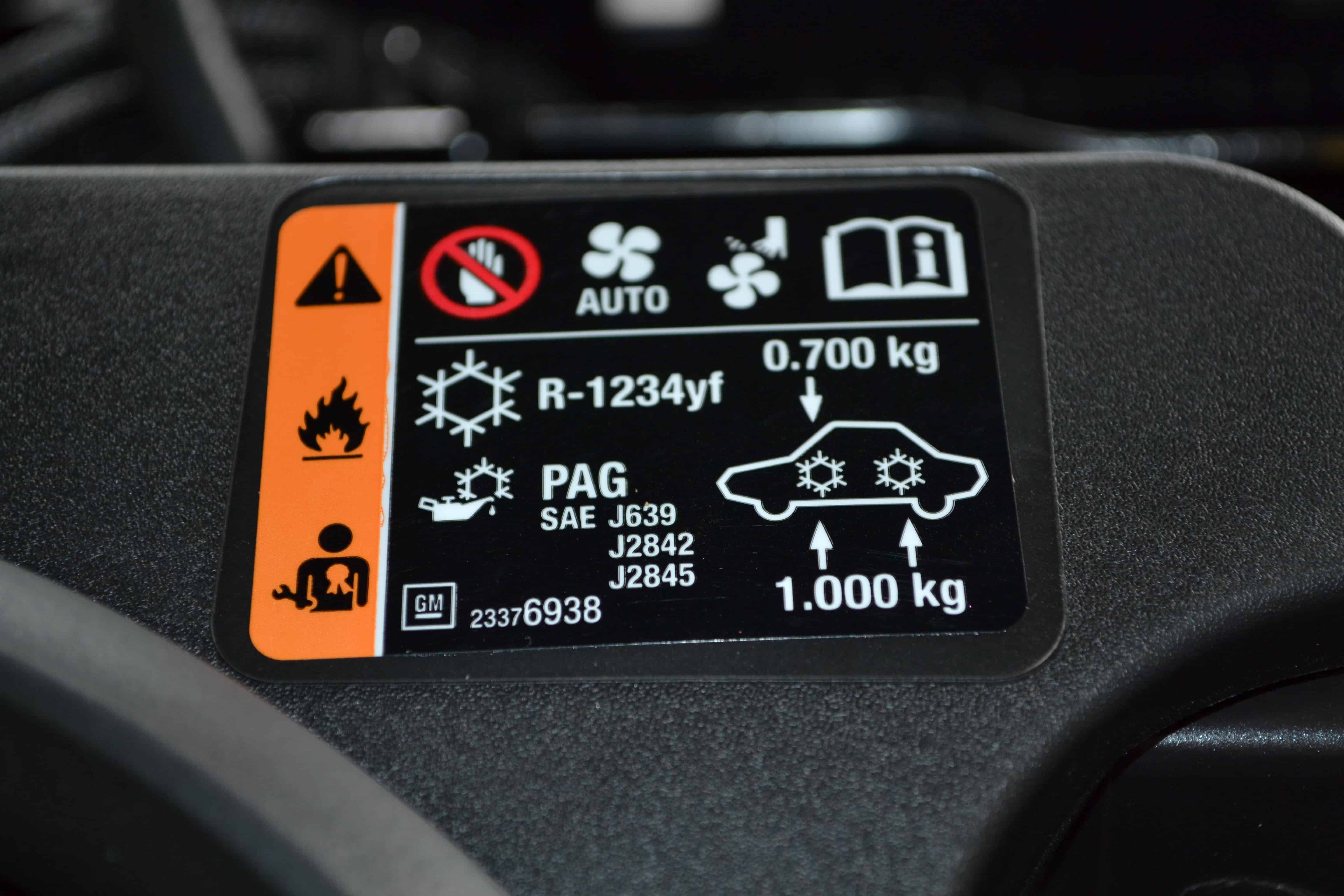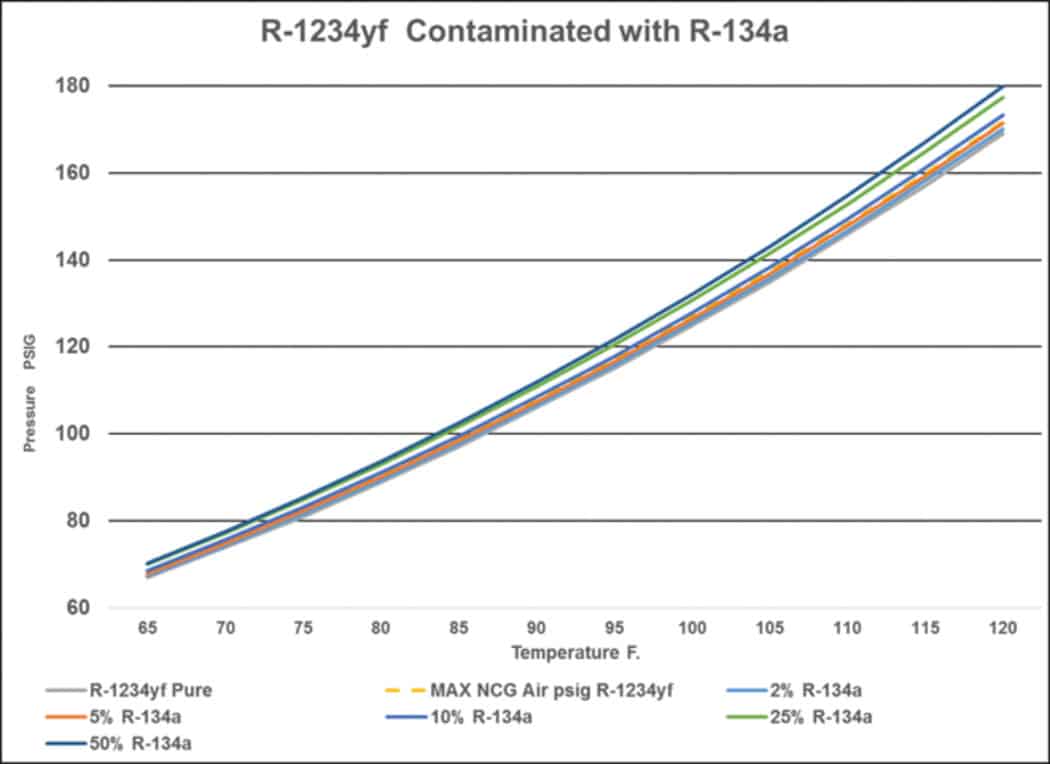Retrofitting R-1234yf mobile air conditioning systems is prohibited
By Ward Atkinson and Bill Hill
Note: The information in this article is the current overview as collected by Ward Atkinson and Bill Hill from industry and regulatory sources. It is not intended to provide all possible issues covering any system modifications and operation or servicing of production R-1234yf mobile air conditioning systems.
The following provides some information on legal and technical issues regarding using a lower cost refrigerant to replace R-1234yf in mobile air conditioning systems.
The Clean Air Act prohibits changing the refrigerant in a system designed to use R-1234yf to any other refrigerant, including R-134a.
Regulatory issues
The EPA staff has explained at various SAE International forums that topping off/filling a vehicle system designed for R-1234yf, which has received emission credits, with any refrigerant other than R-1234yf, is considered “tampering with a vehicle emissions-control device.” This is a violation of Section 203 of the Clean Air Act.
The SNAP (Significant New Alternatives Policy) program has listed three alternative refrigerants with a lower global warming potential as acceptable for use in MAC (Mobile Air Conditioning) systems with some use restrictions. These include R-1234yf, R-152a, and R-744. R-134a will be available, in the future, for servicing the existing R-134a fleet, but cannot be used to service R-1234yf systems.
The SNAP listings for all MAC refrigerants are subject to the use condition of unique fittings for each refrigerant. The purpose of these fittings is to prevent cross-contamination. Using an adapter or deliberately modifying a fitting to use a different refrigerant is a violation of these use conditions. (See Appendix D to 40 CFR part 82, subpart G.) If used properly, the unique fittings will not allow for the introduction of HFC-134a refrigerant to an HFO-1234yf system. The final rule (Rule #20) is available at: https://www.epa.gov/snap/snap-regulations#Rules.
The SNAP July 2015 final rule (80 FR 42953) states that “HFC-134a is listed, and will remain listed, as an acceptable refrigerant for retrofit of existing systems designed to use CFC-12, but because of the use restrictions for refrigerants listed as acceptable, it cannot be used as a retrofit for MAC systems using other alternatives.” For more information, see https://www.epa.gov/snap/motor-vehicle-air-conditioning.
Currently there are many new light-duty vehicles using R-1234yf, since the EPA has allowed manufacturers to apply credits from the use of lower global warming refrigerants toward the CO2 emissions and fuel economy standards. Use of another refrigerant (Including R-134a), due to the refrigerant circuit control calibrations, will cause the system to operate differently than it did in the design certified vehicle using R-1234yf.
Clean Air Act Section 203(a)(3)(A):
“The following acts and the causing thereof are prohibited …for any person to remove or render inoperative any device or element of design installed on or in a motor vehicle or motor vehicle engine in compliance with regulations under this subchapter prior to its sale and delivery to the ultimate purchaser, or for any person knowingly to remove or render inoperative any such device or element of design after such sale and delivery to the ultimate purchaser;”
In an EPA vehicle emissions enforcement letter, dated January 14, 1993, the Office of Air and Radiation in the CIVIL PENALTY POLICY FOR ADMINISTRATIVE HEARINGS issued the following:
“A. Statutory Penalties “
Tampering – Under section 205 of the Act, any manufacturer or dealer who violates the tampering prohibition, (3)(A), is subject to a civil penalty of not more than $25,000 per violation. Any person other than a manufacturer or dealer who violates the tampering prohibition is subject to a civil penalty of not more than $2,500 per violation. Any such violation with respect to the tampering prohibition constitutes a separate offense with respect to each motor vehicle or motor vehicle engine.
Defeat Device – Under section 205 of the Act, any person who violates the defeat device prohibition, (3) (Bl), is subject to a maximum civil penalty of $2,500 per violation. Any such violation with respect constitutes a separate component.”
It should also be noted that since the 1993 letter the Statutory Penalties for “Tampering” have increased from $25,000 to the current penalty of $37,500 for a manufacturer or dealer. A 2016 proposal that is now in the interim final rule stage would increase this to $44,539. The penalty for a “Defeat Device” for an individual was $2,500 per violation and would increase to $4,454.
System cooling performance
There are several design issues between the two refrigerants that may affect maximum cooling performance. Since no information on the exchange of system refrigerant has been released by vehicle manufacturers, there is no information on what may be encountered with a refrigerant change. This may include issues related to cooling performance and durability.
Refrigerant flow devices
The expansion valve setting for R-1234yf refrigerant is different compared to R-134a. Changing from R-1234yf to R-134a refrigerant may result in a system with incorrect refrigerant flow and heat exchanger mal-distribution which may cause a loss of cooling performance or durability concerns.
The TXV setting is also different when an Internal Heat Exchanger (IHX) is used, which is common in R-1234yf MAC systems. This may mean that suction line pressure drop is increased, which might affect the setting for a pressure controlled compressor, resulting in poor cooling or evaporator core freezing.
This can be particularly damaging in the case of dual evaporator systems where the balance of front and rear expansion devices helps to avoid oil trapping in the rear evaporator.
Evaporator control
Evaporator control settings are important both for maximum performance and reduced load requirements at cooler ambient. Depending upon the method of control for maximum cooling performance (pressure or temperature control), different settings may be required when changing the refrigerant.
Refrigerant pressure control of the compressor with either cycling compressors or variable displacement compressors is affected by the refrigerant used in the system. Systems that use air temperature sensing for controlling the evaporator may not be affected by changing from R-1234yf to R-134a.
R-1234yf systems that control freeze protection by pressure may encounter loss of cooling performance if charged with 100% R-134a. This is due to the requirement of R-134a to have a lower setting of 3.3 psig to achieve freeze protection at 32 F. This may result in a 4-degree F. (2.2C.) warmer outlet air temperature.
The mixing of R-134a with R-1234yf will change refrigerant pressure and may result in evaporator freeze-up on pressure control systems, reducing system airflow.
If you’re a service professional and not a MACS member yet, you should be!
Become a member and receive a monthly technical newsletter with information like what you’ve just read in this blog post visit http://bit.ly/10zvMYg for more information.
You can E-mail us at macsworldwide@macsw.org .
To locate a Mobile Air Conditioning Society member repair shop in your area.
Click here to find out more about your car’s mobile A/C and engine cooling system.
Mobile A/C professionals should plan to attend MACS 2017 Training Event and Trade Show, February 15-18 at the Anaheim Marriott in Anaheim, CA.
Click here to see MACS current public training schedule.
The MACS website is located at www.macsw.org



